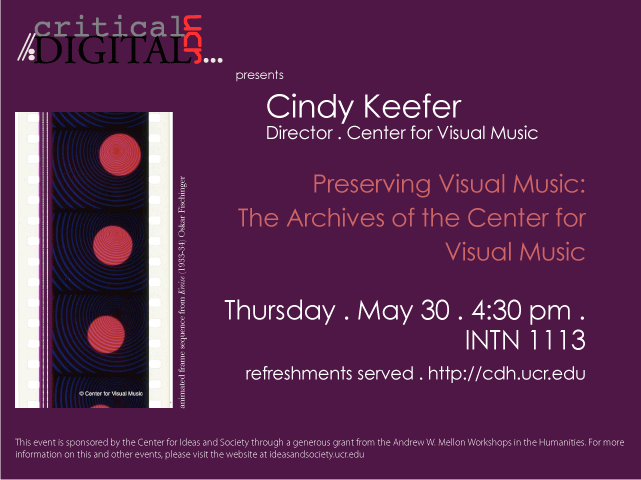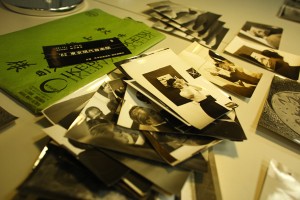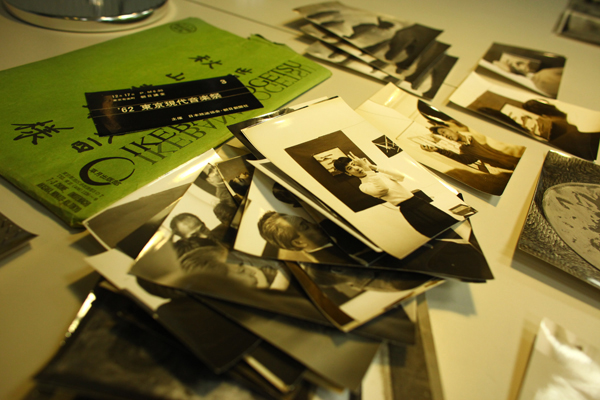Posts from the ‘general digital cultures’ Category
Author: Sarah Lozier
As a humanities graduate student interested in looking at digital media, digital processes, and digital sociality, it is tempting to define myself professionally as a Digital Humanities scholar. But this definition isn’t particularly helpful, since it almost always elicits the response — “And what does that actually mean?” Indeed, being a DH professional seems to “mean” differently for different people, and these definitional slippages become increasingly problematic when it comes to those non-research necessities of being an aspiring academic (getting jobs, applying for grants, and teaching undergraduates). In an effort to think through some of these slippages and their politics, I’d like to look at one specific resource for DH professionalization — the University of Victoria’s Digital Humanities Summer Institute (DHSI) — to think about what this program suggests effective DH professionalization is and does.
The DHSI is “a week of intensive coursework, seminars, and lectures,” all focused around issues pertinent to the digital humanities. This year’s twenty-seven seminars cover a wide range of topics ranging from “Text Encoding Fundamentals” to “Electronic Literature in the Digital humanities,” but all twenty-seven are organized along a kind of divide between building digital skill sets — coding, software use, etc — and dealing with fairly traditional issues of humanities study applied to digital objects — “reading” electronic literature, applying “theory” to digital media, etc.
This divide strikes me as potentially indicative of the larger problem of professionalizing in DH, and that is the question of what a DH professional does. While these seminars cover topics dealing explicitly with navigating the Digital and topics dealing explicitly with navigating the Humanities, there aren’t any seminars that explicitly deal with digital AND humanities navigation, DH as one unit. They suggest that DH is still D and H, Digital and Humanities. The problem with this “and” is analogous to the problem of the hyphen conceived as the splice that Katherine Hayles discusses in the fifth chapter of How We Became Posthuman. That is, D (and) H imagines a “separate but equal” relationship between the items on either side of the and, even as it officially splices them together (DH) as one item. Scholars who do this thing called “DH” must actually do “D and H,” making the discipline a necessarily exclusive rather than inclusive one. In the hectic world of the modern academy, where tenure is disappearing and we are asked more often than not to work “for free,” today, being a DH professional is all but closed off to those who already have the time and resources to equivalently pursue D and H — established, funded academics. Until we can more effectively splice D and H into DH, this exclusivity and definitional slipperiness will continue to exist.
Review: “Media in the Archives: Libraries, Popular Culture, and the Digital” Panel Discussion
October 18th, 2013
Kimberly Hall
by Sarah Lozier
On October 17th, 2013 I had the opportunity to attend a panel discussion hosted by UCR’s History Department on the topic of Media in the Archives. In general, the panelists described various forms that archival work can take, whether one is working in an academically-supported research archives like the Huntington, a corporate pop-cultural exhibition-supported archived like that of NBCUniversal, or a digitized archive of material documents like the California Digital Newspaper Collection (CDNC). Given the range of archives presented, it is no surprise that there were many different strategies for navigating the challenges and perks of archival work. What was perhaps, more surprising, was that there were nearly as many similarities as differences presented, particularly among theoretical axes of authenticity and originality. Here, however, I’d like to focus on one archival issue in particular that did not get much attention, but that can be particularly provocative when material and digital cultures and archives collide—the issue of the User.
The User did enter the conversation yesterday when Brian Geiger described the invaluable role of the untrained, amateur user to correct errors in the text that occur in the digitization process due to the limits of computer-based text recognition. Dr. Geiger pointed out that allowing these amateur users this level of access to affect and change the archival material is a bittersweet affair. On the one hand, it frees up the trained, degree-holding archivists to spend time on work that requires the specialist’s hand; while at the same time potentially expediting the digitization process, and with fewer mistakes, due to an increased human labor force. (This introduces the problem never far from DH labor discussions of Crowd-Sourcing, but that is best saved for another post). On the other hand, the CNDC is still an institutionally accredited archive, and there are very real possibilities that this untrained labor force is introducing as many (if not more damaging) errors to the archival materials than the computer. Indeed, the untrained user could only get this kind of access to a digital archive; the very notion would be unthinkable for a material and physical archive like the Huntington or NBCUniversal’s Archives, where the “user” is either a trained researcher operating under the watchful eye of the archivist, or a spectator who is encouraged to Look-Don’t-Touch.
So who is the archive’s User? What does it mean to really use an archive? Can using be limited to accessing? Or can it be expanded to include interacting, as in the shift of replacing “reader” with “user” in conversations about e-Lit? What are the stakes and potential effects of this conceptual expansion, particularly given the slippery place of labor in accessing, using, and interacting? Are we, the institutionally-supported and access-granted DH scholars, the Privileged Users, willing to support this?
by Ian Ross
The pedagogical implementations of digital technology have been widely hailed, but are frequently implemented in the form of making traditional pedagogical procedures more conveniently accessible (online classrooms, digital office hours, etc.). However, there is a largely ignored degree to which digital production by students is helpful to composition, comprehension, and critical thinking in the classroom. Unfortunately, the primary roadblock to pedagogical digital production in curriculum centering around this production is the inaccessibility of coding as a means of that writing. However, if this process can be made more accessible, the constructed nature of binary code, as well as its inability to work with logical fallacy, has the potential to illustrate much clearer narratological and argumentative skills to novice writers.
In an attempt to work around this problem, I have enacted a classroom project based around the free and universally available program Inform7, an interactive text based video game production space designed to use English language “coding” to create digital spaces with which the audience can interact. The first attempt at this project involved individual students building games using a peer produced message board for guidance, produced limited results, and ended with most students circulating around an “expert” with previous experience. However, the second attempt was designed as a group project and guided by a greater amount of classroom instruction. Students in groups of four posted their games along with the code, and were asked to play the games designed by the three other groups before looking at the code that Inform7 translated into gameplay.
This structure created an identifiable divide between author and audience, and allowed for a direct discussion of narrative production, symbol, icon, and metaphor. The program uses binary logic (i.e. one thing cannot be two things) within an English language code to produce games. Giving “objects” (which are defined by description, portability, and/or their ability to contain other objects) names helped students understand the arbitrary nature of language and concepts like simulacra. For instance, a container is given size by the decoding audience: there is no difference between a “wallet” and a “bucket” unless the programmer provides a difference. Using language to define meaning, and illustrating the degree to which this takes place in everyday life is a central benefit to this project.
Putting the student in the position of the creator allows the student to more clearly understand how creation takes place as well. In my second attempt with this project, students worked around coding limitations in ways that were not apparent to their intended audience when playing. One group built a door called “the laptop”, locked it with “the flashdrive” and then named each attached room a different URL address. This created a user experience of interacting with a spatially static computer, while the translating program understood what was happening as geographical movement and location. Once students outside of the group both looked at the code designed to create this world and had played the game itself, they began to comprehend the degree to which
narrative can potentially step outside of perceived media limitations. Additionally, students who either built or played this specific game were then able to more clearly engage in close reading and authorship when they were confronted with the digital illusion of reality, as well as understand the benefits and meaning production of metaphor.
These were only a few of the ways integrating this process into classroom activity allowed for a deeper and more apparent discussion of the abilities one has access to as a writer as well as the methods of readership which take place invisibly around various socially constructed symbols. Allowing for programs like Inform7, and for the creation of more specialized programming in the classroom like it, is the first important step to bridging the digital divide in a way that will provide students with clear pedagogical connections to necessary comprehension and critical thinking skills.
For those curious, the links to Inform7 (the program used to build these games) and Frotz (the program used to play them) are below. Think of Inform7 as the software (i.e. videogame disc) and Frotz as the hardware (Console system) if the process seems confusing:
Please join us for the Year-End Colloquium for Graduate Students in “BAM.”
Designated Emphasis in Book, Archive, and Manuscript Studies – http://bam.ucr.edu
Friday, June 7, 10:00am to Noon
English Department Conference Room (HMNSS 2212)
Presentations by Steve Anderson, Cori Knight, and Heather Van Mouwerik
Display of printshop projects by Rebecca Addicks, Ann Garascia, Cori Knight, Jessica Roberson, and Anne Sullivan
This will also be a celebration of the new Mellon Workshop Grant awarded to the Material Cultures of the Book Working Group – http://bookhistory.ucr.edu
Cindy Keefer, Archivist, Curator & Director . Center for Visual Music
Preserving Visual Music : The Archives of the Center for Visual Music
THURSDAY . May 30 . 4:30 PM . INTN 1113 . Refreshments served .
Cindy Keefer, Director of the Center for Visual Music Los Angeles, will discuss and screen work by pioneers of kinetic art, abstract animation and pre-digital cinema from CVM’s archives. CVM is a Los Angeles archive dedicated to visual music, experimental animation and abstract media. CVM preserves and promotes films by Oskar Fischinger, Jordan Belson, Charles Dockum, Mary Ellen Bute, Jules Engel, Harry Smith and others, as well as contemporary artists. Keefer will screen work from CVM’s archives by Fischinger and Belson, plus Dockum’s Mobilcolor Projections, Bute’s Abstronics (an early oscilloscope film), a short Bute documentary, and more. She will also discuss Belson’s now legendary 1950s Vortex Concerts, CVM’s work with the Fischinger legacy, current preservation work, and Raumlichtkunst, the new HD 3-screen reconstruction of Fischinger’s 1920s multiple-projector performances, recently exhibited at the Whitney Museum, the Tate Modern, and scheduled for exhibition at the Palais de Tokyo in Paris in summer 2013.
This is the last event CDH will host for the 2012-2013 season. Please join us for this exciting presentation.
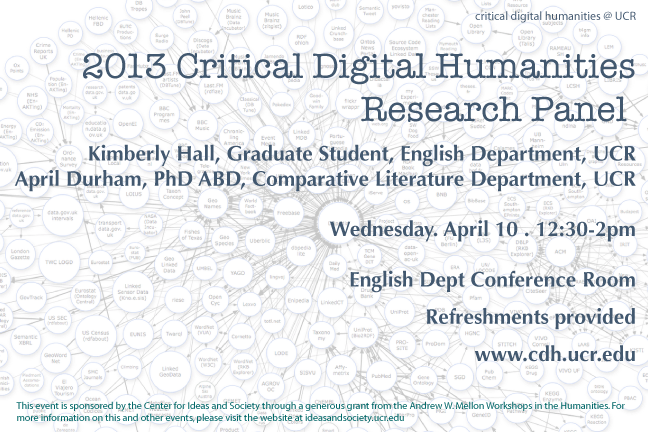 The Critical Digital Humanities presents a CDH research panel with presentations by April Durham and Kimberly Hall. They will present drafts of recent research in digital humanities for discussion and comment.
The Critical Digital Humanities presents a CDH research panel with presentations by April Durham and Kimberly Hall. They will present drafts of recent research in digital humanities for discussion and comment.
Wednesday . April 10 . 12:30 – 2
English Department Conference Room
Refreshments will be served.
The Museum of Modern Art launches post, a participatory digital platform for global research
February 20th, 2013
April Durham
The Museum of Modern Art launches post,
a participatory digital platform for global research
post is an open forum for sharing research and circulating works in progress, offering a platform for critical response and an instrument for increasing expertise through exposure to ideas from around the globe. It is a place for conversation and debate, for building a nuanced understanding of the histories that shape our present. As a Web platform, post provides an alternative to the model of a unified art-historical narrative. post instead allows a malleable, layered understanding of multiple notions of modernity to emerge over time, as more people from more places participate.
Emerging out of research undertaken at MoMA, post develops a network of partners and users whose complementary research and concerns will shape future approaches and content. Starting with a specific thematic focus, the site regularly releases essays, interviews, reports, reflections, archival materials, and artists’ commissions, ensuring that new voices are constantly entering the discussion. The site is designed to encourage active participation; users and institutional partners are encouraged to upload their own findings and share their questions, together gaining broader exposure and expertise. In time, and depending upon the interest of the partners, post will broaden its focus.
Committed to investigating artistic practices that have historically been overlooked in MoMA’s collection and exhibitions, post initially explores sites of experimental practices in regions that are the focus of C-MAP research: East Asia, Central and Eastern Europe, and Latin America and the Caribbean. Upon its launch, post will present its first case study, in partnership with Keio University Art Center, featuring the archival materials of Sogetsu Art Center, an epicenter of avant-garde artistic experiments in Tokyo in the 1960s that hosted an exciting, rapid-fire series of programs in experimental music, jazz, and cinema. The initial presentation features essays, interviews, and works by artists related to Sogetsu Art Center—Shiomi Mieko, Yokoo Tadanori, Matsumoto Toshio, andYamaguchi Katsuhiro—and artists who have been the subject of C-MAP research—Geta Brătescu, Chim↑Pom, and Jikken Kobo, among others.
About C-MAP
C-MAP research questions the judgments that grow out of the assumption that artistic modernism is or was determined solely by Western European and North American narratives of early-20th-century avant-gardes. The aim of C-MAP is to understand more fully the historical imperatives and changing conditions of transnational networks of artistic practice, and to seek verbal and material accounts of histories that are little known outside their countries of origin. C-MAP forges new relationships and partnerships and undertakes collaborative research in order to develop new expertise, share what has been learned, and, ultimately, inform the development of exhibitions, publications, educational programs, and MoMA’s collection for the benefit of scholars, curators, educators, students, critics, artists, and the general public.
The Museum of Modern Art’s Contemporary and Modern Art Perspectives in a Global Age Initiative (C-MAP) is supported by The Andrew W. Mellon Foundation and The International Council of The Museum of Modern Art.
Additional funding is provided by Patricia Phelps de Cisneros, Adriana Cisneros de Griffin, and Marlene Hess.
post was designed and developed by TC Labs. Creative direction by Caleb Waldorf.
This is a fantastic conference that is devoted to interdisciplinary exploration of topics of concern to anyone working in, with, or around the digital humanities. The conference for next year is at Notre Dame and the deadline for submissions is April 15. Plenty of time to plan a panel!!
27th Annual Conference of the SLSA (Society for Literature, Science, and the Arts)
- POSTNATURAL?
- October 3-6, 2013
- The Campus of the University of Notre Dame
- Proposals due: April 15, 2013
Last year panels included papers by Katherine Hayles, Cary Wolfe, Mark Hansen, and plenty of non-celeb scholars who discussed questions of the “Non-Human” relative to literature, art, humanities generally, and science. They are open to panel proposals and individual papers.
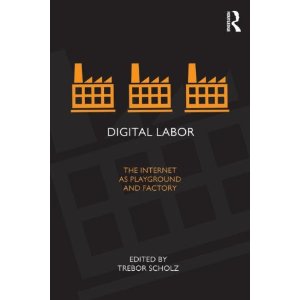 Digital Labor: The Internet as Playground and Factory
Digital Labor: The Internet as Playground and Factory
Edited by Trebor Scholz
Digital Labor asks whether life on the internet is mostly work, or play. We tweet, we tag photos, we link, we review books, we comment on blogs, we remix media, and we upload video to create much of the content that makes up the web. And large corporations profit on our online activity by tracking our interests, affiliations, and habits—and then collecting and selling the data. What is the nature of this interactive ‘labor’ and the new forms of digital sociality that it brings into being? The international, interdisciplinary contributors to Digital Labor suggest that there is no longer a clear divide between ‘the personal’ and ‘work,’ as every aspect of life drives the digital economy: sexual desire, boredom, friendship—and all become fodder for speculative profit. They argue that we are living in a total labor society and the way in which we are commoditized, racialized, and engendered is profoundly and disturbingly normalized by the dominant discourse of digital culture. Digital Labor poses a series of questions about our digital present: How is the global crisis of capitalism linked to the hidden labor of the digital economy? How do we address that most online interaction, whether work or play, for profit or not, is taking place on corporate platforms? How can we acknowledge moments of exploitation while not eradicating optimism, inspiration, and the many instances of individual financial and political empowerment? In response to these questions, this collection offers new definitions of digital labor that address and challenge the complex, hybrid realities of the digital economy.
Introduction: Trebor Scholz Why Does Digital Labor Matter Now? I. The Shifting Sites of Labor Markets
1. Andrew Ross On the Digital Labor Question
2. Tiziana Terranova Free Labor
3. Sean Cubitt The Political Economy of Cosmopolis
4. McKenzie Wark Considerations on A Hacker Manifesto II. Interrogating Modes of Digital Labor
5. Ayhan Aytes Return of The Crowds: Mechanical Turk and Neoliberal States of Exception
6. Abigail De Kosnik Fandom as Free Labor
7. Patricia Clough The Digital, Labor and Measure Beyond Biopolitics
8. Jodi Dean Whatever Blogging III. The Violence of Participation
9. Mark Andrejevic Estranged Free Labor
10. Jonathan Beller Digitality and The Media of Dispossession
11. Lisa Nakamura Don’t Hate the Player, Hate the Game: The Racialization of Labor in World of Warcraft IV. Organizing Networks in an Age of Vulnerable Publics
12. Michel Bauwens Thesis on Digital Labor in an Emerging P2P Economy
13. Christian Fuchs Class and Exploitation on the Internet
14. Ned Rossitter and Soenke Zehle Acts of Translation: Organizing Networks as Algorithmic Technologies of the Common
I heard about this summer workshop that might interest some of us. It’s at UC Irvine and includes travel, lodging, and food costs for the week.
Values in Design Workshop – August 19-26, 2012
Take part in an intensive one-week workshop on values in the design of information systems and technology. Doctoral students at any stage from a variety of disciplines are invited to attend, including – but not restricted to – informatics, computer science, science studies, design, visual arts, and social entrepreneurship. Travel, food, and lodging will be covered, though accepted participants are encouraged to seek support from their home institutions.
The workshop will be restricted to twenty (20) students. Mornings will be devoted to discussing a judicious mix of readings and exercises from the fields above, led by Geoffrey C. Bowker, Judith Gregory, and Cory Knobel. In the afternoons, students will work in interdisciplinary groups to produce a project plan incorporating strong social values into information systems and technology, with guest lectures from thought leaders such as Paul Dourish, Helen Nissenbaum, and Carl DiSalvo throughout the week. The workshop will close with project presentations to a panel of academics and entrepreneurs. We will offer support and rewards for projects that continue on to working prototypes and project launch.
Except where otherwise noted, content on this site is licensed under a Creative Commons License.

